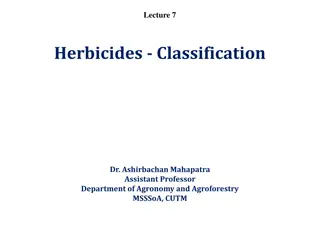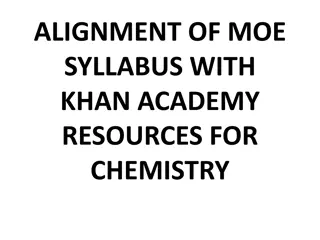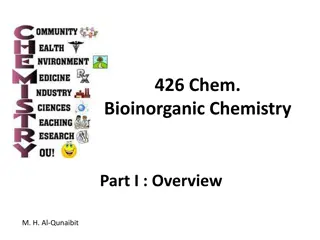The Role of Inorganic Nitrate in Preventing Contrast-Induced Nephropathy
Contrast-Induced Nephropathy (CIN) poses risks to patients undergoing angiography. This study evaluates the potential benefits of dietary inorganic nitrate in preventing CIN and its mechanisms. Results show promising renoprotective effects, highlighting a potential preventive approach for at-risk pa
1 views • 25 slides
Organometallic Chemistry (CHEM 42 1)
Organometallic chemistry delves into compounds with carbon-metal bonds, merging concepts from inorganic and organic chemistry. The field encompasses diverse compounds like ferrocene and tris(triphenylphosphine)rhodium carbonyl hydride, with nomenclature based on naming organic groups and adding meta
1 views • 13 slides
Introduction to Co-ordination Chemistry: Fundamentals and Applications
Explore the fascinating field of coordination chemistry, delving into the complexity of compounds and the coordination bonds that govern their structures. Discover the history, key concepts, and applications of coordination chemistry through a detailed examination of coordination compounds, bonding
14 views • 73 slides
Physiological Acid-Base Balance in Pharmaceutical Inorganic Chemistry
This lecture delves into the fundamental concepts of pharmaceutical inorganic chemistry, focusing on the mechanisms and uses of various pharmaceutical products that correct body disorders. Topics covered include acids and bases, intra and extracellular electrolytes, and the role of buffers in mainta
10 views • 14 slides
Overview of Herbicides Classification and Groups
Herbicides are classified based on their chemical nature into inorganic and organic types. Inorganic herbicides, such as arsenic acid and copper sulfate, do not contain carbon atoms, while organic herbicides, like glyphosate and 2,4-D, contain carbon atoms. The classification includes various groups
4 views • 15 slides
Fuel Your Success Conquer the IB Chemistry (SL and HL) Examination
Ignite your potential and achieve excellence in the IB Chemistry (SL and HL) Examination with our comprehensive study resources. Access practice exams, study guides, and expert guidance to excel in your test. Start your journey towards academic success today!\nClick Here to Get IB-Chemistry Dumps Wi
4 views • 6 slides
Role of Chemistry in Pharmaceutical Sciences
Medicines and drugs used for treating diseases are organic or inorganic chemicals. Studying drug chemistry is essential for pharmacists. This course covers fundamentals of chemistry, states of matter, radiochemistry, thermodynamics, kinetics, and chemical equilibria. Important subtopics include atom
2 views • 35 slides
Minerals: A Comprehensive Guide
Earth's crust is composed of rocks made up of different minerals, which are naturally occurring, inorganic solids with distinct atomic structures and chemical compositions. Minerals exhibit properties like solidity, natural occurrence, inorganic nature, fixed composition, and crystal form. Identifyi
3 views • 20 slides
Introduction to Bioinorganic Chemistry and Essential Elements in Human Body
Bioinorganic Chemistry explores the role of inorganic elements in living systems, emphasizing the essential elements present in the human body. Understanding the significance of metals, such as calcium, potassium, and iron, highlights their crucial functions and the impact of deficiency or excess on
5 views • 21 slides
Supramolecular Chemistry: Insights and Applications
Supramolecular chemistry delves into the chemistry of molecular assemblies, intermolecular bonds, and non-covalent interactions, leading to the formation of supra-molecules through aggregation of molecular subunits. Concepts like molecular recognition, self-organization, and host-guest chemistry pla
0 views • 18 slides
Impact of Land-Use Consolidation Program on Farm Inputs in Rwanda
The study evaluates the effects of Rwanda's land-use consolidation program on farm input uptakes, specifically focusing on hybrid seeds, inorganic fertilizers, and pesticides. Results show significant increases in the adoption of hybrid seeds and inorganic fertilizers among participating households
0 views • 10 slides
Environmental Chemistry Open Course: Understanding Pollution and Control Measures
Dive into the world of environmental chemistry with this comprehensive open course offered by the Department of Chemistry. Explore the causes, effects, and control measures of air, water, soil, noise, thermal, light, and radioactive pollutions. Gain insights into pollution terminology, water quality
3 views • 9 slides
Innovative Use of Sea Water in Drilling Fluid Development
This work focuses on leveraging sea water as an alternative to inorganic salts in drilling fluid formulations, reducing logistical costs and enhancing offshore operations. The development process involved scaling down additives to nano-size, aiming to create a product that not only replaces Lime in
1 views • 10 slides
Inorganic Pharmaceutical Chemistry: Applications and Importance
Inorganic pharmaceutical chemistry explores the study of elements and compounds excluding carbon, with diverse applications in pharmacy. It encompasses the synthesis and use of inorganic compounds in drug development, catalysis, pigments, and agriculture. The field also delves into the medicinal val
3 views • 6 slides
Fertilizers and Their Types
Fertilizers are essential for plant growth, providing nutrients necessary for healthy development. They are classified into organic and inorganic types, each with its own advantages and disadvantages. Organic fertilizers, sourced from natural materials like plants and animals, enrich the soil with o
2 views • 7 slides
Overview of Herbicides Classification and Chemical Nature
Herbicides are classified based on their chemical nature into inorganic and organic herbicides. Inorganic herbicides do not contain carbon atoms, while organic herbicides contain carbon atoms. They are further categorized into 31 classes, each with distinct properties and modes of action. This class
0 views • 15 slides
Angular Overlap Method in Advanced Inorganic Chemistry
Exploring the Angular Overlap Method (AOM) in advanced inorganic chemistry provides a qualitative discussion on the physical rationale behind the theory of complexes. By considering the interaction of atomic orbitals and the degree of overlap, AOM offers insights into energy quantification in coordi
0 views • 15 slides
Rodenticides: Types, Effects, and Treatment
Rodenticides are chemical preparations used for rodent control, primarily targeting mice and rats. They play a crucial role in managing rodent populations to prevent associated losses. The chapter covers an introduction to rodenticides, their classification into organic and inorganic types, mechanis
0 views • 19 slides
Chemistry through Open-Ended Questions
The content provides a detailed assessment of student responses to open-ended chemistry questions related to hydrogen peroxide and its applications in teeth whitening gels. Various student answers are analyzed based on their understanding of the chemistry concepts involved, with explanations given f
1 views • 18 slides
Comprehensive Alignment of MOE Chemistry Syllabus with Khan Academy Resources
This comprehensive alignment showcases the correlation between the Ministry of Education (MOE) chemistry syllabus and the educational resources provided by Khan Academy. It covers various topics in chemistry such as the particulate nature of matter, atomic structure, chemical bonding, stoichiometry,
1 views • 9 slides
Bioinorganic Chemistry: Connecting Inorganic and Biochemistry
Bioinorganic Chemistry bridges the gap between inorganic chemistry and biochemistry, understanding the vital role of inorganic elements in living systems. This interdisciplinary field delves into the structure, function, and exploitation of metal ions in biological processes, emphasizing their inter
0 views • 47 slides
UC Riverside Chemistry Program: Excellence in Education and Research
UC Riverside's Chemistry Program offers a range of options in ACS-accredited Chemistry education, with highlights including a distinguished faculty, substantial research funding, and high rankings. The program also boasts a Nobel Prize-winning faculty member and a comprehensive curriculum that cover
0 views • 5 slides
Overcoming Misconceptions in Chemistry Education
Addressing misconceptions in general chemistry education, focusing on student knowledge from high school Math and Chemistry courses. Emphasis on student motivation, learning strategies, and common misconceptions in understanding scientific concepts. Strategies for enhancing comprehension, applicatio
0 views • 12 slides
Innovations in Winery Cleaning Chemistry for Sustainability
Explore the future of winery cleaning chemistry through leveraging technology and sustainable practices. Considerations for chemistry selection focusing on safety, hazardous materials, employee well-being, and environmental impact are highlighted. Current cleaning chemistry practices, including the
0 views • 19 slides
Overview of LJMU Chemistry for All Programme Summer Internship Project
LJMU's Chemistry for All Programme aims to enhance student experiences through summer internships, curriculum development, and outreach activities. The project, funded by the Royal Society of Chemistry, involves a cross-university collaboration to engage local schools and foster interest in chemistr
2 views • 21 slides
Overview of Wastewater Treatment Units and Processes
Screening units with screens and racks remove coarse solids, comminutors reduce the size of suspended solids, and grit chambers remove sand and metal fragments from wastewater to protect downstream equipment and processes. The floatation tank removes grease, while different designs of grit chambers
5 views • 15 slides
Coordination Numbers in Inorganic Compounds: Geometries and Structures
In inorganic coordination complexes, the coordination number refers to the number of atoms bonded to the central atom. Common geometries include octahedral, tetrahedral, and square planar, depending on the type and number of ligands. Transition metal complexes exhibit different coordination numbers
2 views • 8 slides
Isomerism in Inorganic Complexes: A Comprehensive Overview
Isomerism in inorganic complexes is a fascinating phenomenon arising from the specific spatial arrangements of atoms within molecules. This article delves into the types of isomerism found in coordination compounds, such as structural isomerism and stereoisomerism. The importance of studying isomers
0 views • 67 slides
Impact of Replacing Inorganic Zinc with Organic Zinc on Buffalo Calves
The study explores the effects of replacing inorganic zinc with a lower level of organic zinc (zinc propionate) on performance, biochemical constituents, and mineral status in buffalo calves. Zinc deficiency is a critical issue affecting growth, immunity, and reproduction in livestock. Inorganic min
0 views • 27 slides
Integrated Terrestrial-Coastal Ocean Framework for Carbon Management
An advanced framework integrating terrestrial and coastal ocean observations and modeling is developed to support carbon management decisions. The study focuses on assessing the impacts of land use, human activities, and climate scenarios on the carbon cycle, particularly dissolved inorganic carbon
1 views • 5 slides
Methods of Business Expansion and Key Terms Explained
Methods of business expansion can be organic or inorganic, with inorganic methods including strategic alliances, mergers, and takeovers. Key terms such as inorganic growth, joint ventures, acquisitions, and subsidiaries are crucial for understanding business expansion strategies.
0 views • 23 slides
Organic Chemistry and Macromolecules
Organic chemistry focuses on compounds with carbon bonds, while inorganic chemistry deals with other compounds. Carbon is unique due to its ability to form multiple bonds, creating diverse structures like chains and rings. Organic compounds, produced by living organisms, range from simple to complex
0 views • 32 slides
Royal Society of Chemistry Food Group Vision & Mission Summary
The Royal Society of Chemistry Food Group aims to lead, promote, and disseminate the understanding and importance of chemistry in food. Their vision is to enhance food and nutrition security through advancing the chemistry of food ingredients. They strive to engage with various communities to promot
2 views • 4 slides
Chemistry 1151K Course Overview and Chapters Summary
Upon completion of the CHEM 1151K course, students will apply the scientific method to investigate chemical questions in allied health, utilize dimensional analysis to solve quantitative problems, communicate effectively using chemical terminology and symbols, describe the behavior of biochemical so
0 views • 44 slides
Biochemistry and Chemistry Elective Courses Overview at SRCASW
The Shaheed Rajguru College of Applied Sciences for Women offers elective courses in Biochemistry and Chemistry. The Biochemistry course covers biomolecules like amino acids, proteins, carbohydrates, lipids, and nucleic acids, emphasizing their properties and functions. It also includes practical ex
0 views • 19 slides
Heterotrophic Nutrition in Organisms
Heterotrophic nutrition refers to the process where organisms, such as animals, rely on preformed organic molecules from their environment or other organisms for nutrients and energy. These organisms are unable to produce organic compounds from inorganic sources and must obtain nourishment from exte
0 views • 55 slides
Analysis of Inorganic Fertilizer Supply Chain in Uganda
Examining the accessibility and quality of inorganic fertilizers in Uganda, the study focuses on key regions, targeted fertilizers, methodology, findings on moisture content and weight compliance, and implications for farmers. The research sheds light on challenges and opportunities in the country's
0 views • 17 slides
Essential Nutrients for Plant Tissue Cultures: A Comprehensive Guide
The composition of culture media for plant tissue cultures includes inorganic and organic nutrients, sources of energy like sucrose and amino acids, and essential macro and micronutrients. Providing gas exchange, waste removal, and growth regulators, the medium supports plant growth by offering acce
0 views • 22 slides
Organic Chemical Constituents
A variety of organic compounds can impact water quality, leading to taste, odor, and toxicity issues. Organic substances are composed of carbon, hydrogen, nitrogen, and oxygen, and can originate from natural sources, human activities, or chemical reactions during disinfection. Differentiating organi
0 views • 16 slides
Organometallic Chemistry Overview
Organometallic chemistry involves compounds with carbon-metal bonds, combining aspects of inorganic and organic chemistry. Learn about nomenclature, examples, and more in this field.
0 views • 15 slides







































